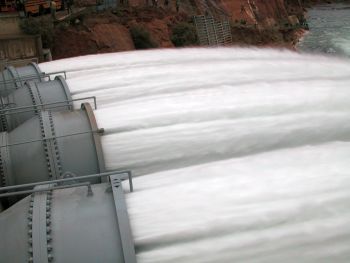
Publisher:
Bonnie King
CONTACT:
Newsroom@Salem-news.com
Advertising:
Adsales@Salem-news.com

~Truth~
~Justice~
~Peace~
TJP
Mar-06-2008 07:38

 TweetFollow @OregonNews
TweetFollow @OregonNews
Grand Canyon Flood Experiment Now Underway
Salem-News.comScientists hope to gain a better understanding about whether higher flows created by releasing water from the dam can be used to rebuild eroded beaches downstream.
 Glen Canyon Dam bypass tubes Photo courtesy: USGS |
(PAGE, Ariz. ) - Secretary of the Interior Dirk Kempthorne Wednesday morning opened jet tubes at Glen Canyon Dam to release about 41,500 cubic feet per second of Colorado River water into the Grand Canyon. The Secretary’s action launched a scientific experiment aimed at learning more about how to improve the river for wildlife and visitors.
The experiment is a 60-hour “high flow test.” The additional water is expected to push sand built up at the bottom of the river’s channel into a series of sandbars and beaches along the river. “This experiment has been timed to take advantage of the highest sediment deposits in a decade and designed to better assess the ability of these releases to rebuild beaches that provide habitat for endangered wildlife and campsites for thousands of Grand Canyon National Park tourists,” Secretary Kempthorne said. “The water will be released at a rate that would fill the Empire State Building within twenty minutes. It will transport enough sediment to cover a football field 100 feet deep with silt and sand.”
The experiment is an inter-agency research effort conducted by three Department of the Interior bureaus – the U.S. Geological Survey (USGS); the Bureau of Reclamation, which operates Glen Canyon Dam on the Colorado River; and the National Park Service (NPS), which manages Grand Canyon National Park.
Joining the Secretary were Bureau of Reclamation Commissioner Bob Johnson, USGS Director Mark Myers, NPS Director Mary Bomar, USGS Southwest Biological Science Center director Andrea Alpine, Grand Canyon National Park superintendent Steve Martin, Regional Director Larry Walkoviak of the Bureau of Reclamation-Upper Colorado Region, Southwest Regional Director Ben Tuggle of the Fish and Wildlife Service and Regional Environmental Protection Officer Amy Heuslin of the Bureau of Indian Affairs.
Evaluation of the results of the release will be part of an effort to fashion a long-term, science-based adaptive management process. Scientists hope to gain a better understanding about whether higher flows created by releasing water from the dam can be used to rebuild eroded beaches downstream.
Colorado River sandbars within Grand Canyon not only provide habitat for wildlife and camping beaches for recreationists, but also supply sand needed to protect archaeological sites. High flows also create areas of low-velocity flow, or backwaters, used by young native fishes, particularly endangered humpback chub. Most sediment entering Grand Canyon National Park now arrives from the Paria River and upper Marble Canyon tributaries below the dam.
The 2008 test is different than previous high-flow tests conducted in 1996 and 2004. In particular, scientists have concluded that more sand is needed to rebuild sandbars throughout the 277-mile reach of Grand Canyon National Park than was available in 1996 or 2004. Currently, sand supplies in the river are at a 10-year high with a volume about three times greater than the volume available in 2004 due to tributary inflows below the dam over the past 16 months.
The Bureau of Reclamation will release water from both the powerplant and the bypass tubes at Glen Canyon Dam to a maximum amount of approximately 41,500 cubic feet per second (cfs) for 60 hours. Since 1996, releases from Glen Canyon Dam have generally ranged between 8,000 and 20,000 cfs. The temporary increase to 41,500 cfs will change river conditions downstream of the dam as well as the availability of campsites. It is suggested that all river users be prepared for variable conditions, including higher river flows.
“The water released during the test will not change the amount of water to be released over the course of the 2008 water year,” said Larry Walkoviak, Regional Director of Reclamation’s Upper Colorado Region. “The current plan of operations calls for releasing 8.23 million acre-feet of water from Glen Canyon Dam. That water flows downriver to Lake Mead for use by the Lower Colorado River Basin States and Mexico. The experimental flows are included within this annual volume. Monthly releases later in the year will be adjusted downward to account for the water released during the experiment.”
To conduct the experiment, researchers from Interior’s USGS Grand Canyon Monitoring and Research Center are working with scientists and resource managers from Reclamation, the Fish and Wildlife Service and the National Park Service, as well as the Arizona Game and Fish Department, Northern Arizona University and other cooperators.
A major portion of the research is focused on the well-being of native fish. The humpback chub, an endangered species, is one of four remaining native fish in the Grand Canyon. USGS scientists will be monitoring how the high-flow releases affect the survival of a population of young humpback chub.
Data will be collected to determine the amount of sediment available in the system and its availability for restoring sandbars and camping beaches. Researchers will also collect data on the changes in sandbars before, during, and after the high flow. This data will be used to improve the predictive capabilities of the existing sediment model and determine the optimal peak flows of future high-flow experiments.
Articles for March 5, 2008 | Articles for March 6, 2008 | Articles for March 7, 2008

Salem-News.com:
googlec507860f6901db00.html



Terms of Service | Privacy Policy
All comments and messages are approved by people and self promotional links or unacceptable comments are denied.
[Return to Top]
©2025 Salem-News.com. All opinions expressed in this article are those of the author and do not necessarily reflect those of Salem-News.com.